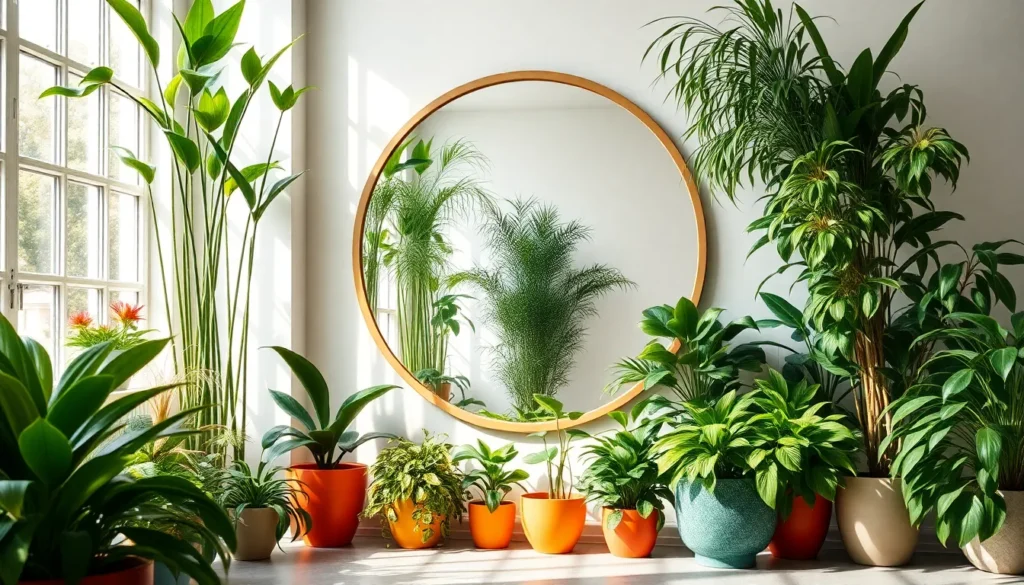We’ve all experienced that moment when we walk into a room and something just feels right. More often than not it’s the perfect balance of natural elements and thoughtful design that creates this magic. When you combine mirrors with strategically placed plants you’re not just decorating – you’re creating an atmosphere that transforms your entire space.
Mirrors with plants around them have become one of the most sought-after design trends and for good reason. This powerful combination amplifies natural light doubles the visual impact of your greenery and creates the illusion of a larger more vibrant space. Whether you’re working with a small apartment or a spacious home this pairing delivers both style and functionality.
We’re about to show you exactly how to master this trend from choosing the right plants to positioning your mirror for maximum impact. Get ready to discover why interior designers everywhere are obsessing over this simple yet groundbreaking approach to home décor.
Transform Your Space With Strategic Plant Placement Around Mirrors
Strategic placement transforms ordinary mirrors into stunning focal points that amplify both natural light and your plant collection’s beauty. We’ll explore how thoughtful positioning creates depth while maximizing the visual impact of your greenery.
Choose Plants That Complement Your Mirror’s Style
Modern minimalist mirrors pair beautifully with architectural plants like snake plants, ZZ plants, or fiddle leaf figs. These clean-lined varieties echo contemporary design while maintaining visual balance without overwhelming sleek surfaces.
Ornate vintage mirrors shine when surrounded by cascading plants such as pothos, ivy, or string of pearls. Trailing varieties soften elaborate frames while creating romantic, layered textures that enhance traditional aesthetics.
Geometric mirrors work best with structured plants like succulents, air plants, or small palms. Angular shapes complement hexagonal or triangular mirrors while maintaining the crisp, organized appearance that defines modern geometric design.
Round mirrors benefit from plants with varied heights and textures including monstera, rubber trees, or peace lilies. Circular frames naturally balance asymmetrical plant arrangements while creating ever-changing visual interest through contrasting shapes.
Consider Light Requirements When Selecting Plants
High light areas near south-facing mirrors support sun-loving plants like croton, rubber trees, or bird of paradise. These locations receive 6+ hours of direct sunlight daily, making them perfect for plants that thrive in bright conditions.
Medium light spaces around east or west-facing mirrors accommodate versatile plants such as monstera, pothos, or philodendrons. These areas receive 3-6 hours of indirect sunlight, supporting most popular houseplants without risk of burning.
Low light corners with north-facing mirrors require shade-tolerant plants like snake plants, ZZ plants, or Chinese evergreens. These resilient varieties thrive in minimal lighting while still providing the lush greenery that enhances mirror displays.
Artificial light setups allow unlimited plant choices when combined with grow lights positioned strategically around mirrors. LED grow lights placed 12-18 inches from plants enable exotic varieties like orchids or fiddle leaf figs to flourish in any location.
Create Depth and Dimension Using Layered Plant Heights
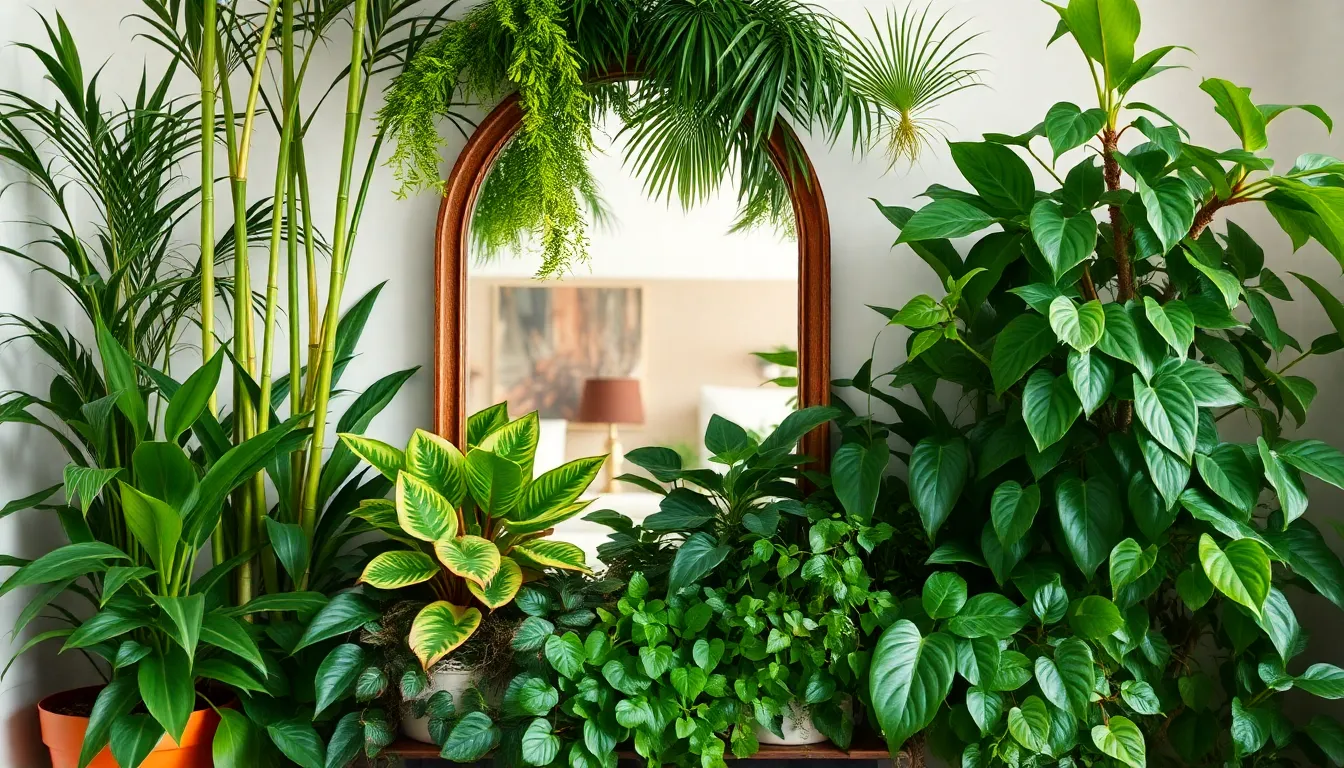
Layering plant heights transforms a simple mirror into a ever-changing focal point that captures attention and creates visual depth throughout your space.
Position Tall Plants Behind the Mirror
We recommend placing tall plants such as bamboo, palms, or towering leafy varieties directly behind your mirror to establish a stunning backdrop. These elevated plants create vertical height that frames the mirror elegantly while their reflections extend the visual space dramatically. Bamboo adds architectural structure, while palms bring tropical elegance that enhances the lush atmosphere of any room. The mirror’s reflective surface amplifies these tall plants, making them appear to double in size and creating an illusion of expanded space that brightens your entire area.
Add Medium-Sized Plants at Mirror Level
Medium-sized plants positioned at your mirror’s level serve as the perfect transitional layer between towering background plants and lower greenery. Fiddle leaf figs offer broad, sculptural leaves that create bold statements, while snake plants provide striking vertical lines with minimal maintenance requirements. Peace lilies contribute soft, graceful foliage that balances the overall composition beautifully. We place these plants at the mirror’s base or adjacent areas to soften the contrast between different plant heights, ensuring a harmonious flow that draws the eye naturally across the entire display.
Include Trailing Plants Below for Visual Flow
Cascading plants below or around your mirror add essential movement and softness that completes the layered design. Pothos creates lush, flowing vines that direct the eye naturally downward, while string of pearls offers unique texture with its distinctive bead-like appearance. Ivy provides classic trailing elegance that works with virtually any mirror style or room decor. These flowing plants establish a continuous connection between your mirror and surrounding greenery, improving visual interest while creating the perception of natural growth that makes your space feel alive and inviting.
Maximize Natural Light Reflection With the Right Plant Choices
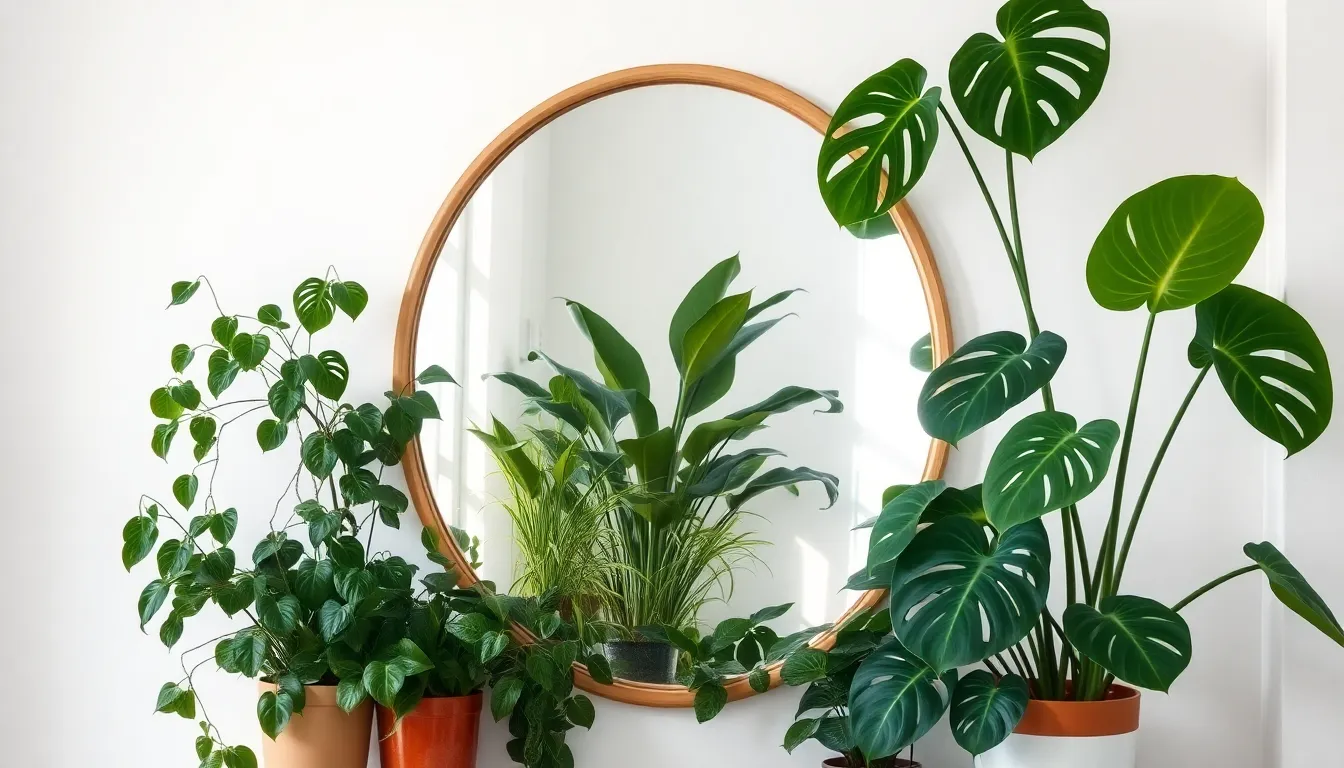
We can dramatically improve our mirror and plant combination by selecting varieties that work with reflected light rather than against it. The key lies in understanding how mirrors redirect natural sunlight and choosing plants that’ll thrive in these exact lighting conditions.
Select Plants That Thrive in Bright, Indirect Light
We should focus on plants adapted to bright, indirect sunlight since mirrors bounce light rather than intensify it directly. Leafy vegetables like spinach and chard excel in these reflected light conditions, making them excellent choices for functional mirror gardens. Many indoor foliage plants also flourish under these circumstances, giving us plenty of decorative options.
Root vegetables and fruiting plants require more direct sunlight exposure, so they won’t benefit as much from our mirror setup. We’ll get better results by avoiding these sun hungry varieties and sticking with plants that naturally prefer filtered or indirect lighting conditions.
Some excellent bright, indirect light plants for our mirror arrangements include:
- Pothos varieties that cascade beautifully around mirror edges
- Snake plants that add vertical structure without demanding direct sun
- Peace lilies that bloom reliably in reflected light conditions
- Rubber trees that develop glossy leaves in bright, indirect settings
Use Glossy-Leaved Plants to Enhance Light Reflection
We can multiply our lighting effects by choosing plants with naturally glossy, shiny leaf surfaces. These smooth textured leaves reflect additional light within our space, creating a compounding effect that benefits all nearby plants. This synergy between mirrors and glossy foliage helps brighten the entire area while improving plant vigor across the board.
Plants with reflective leaf surfaces work as natural light amplifiers in our mirror setups. We’ll notice how their smooth surfaces bounce light in multiple directions, effectively increasing the available illumination for photosynthesis. This creates an optimal growing environment that supports healthier, more vibrant plant displays.
Top glossy leafed plants that enhance our mirror’s light reflection include:
- Fiddle leaf figs with their large, waxy surfaces
- Monstera deliciosa featuring naturally glossy, split leaves
- ZZ plants that maintain their shine in various light conditions
- Philodendrons with heart shaped, reflective foliage
- Rubber plants that develop increasingly glossy leaves over time
We should position these reflective plants strategically around our mirrors to maximize the light bouncing effect throughout the space.
Design Symmetrical Plant Arrangements for Balanced Appeal
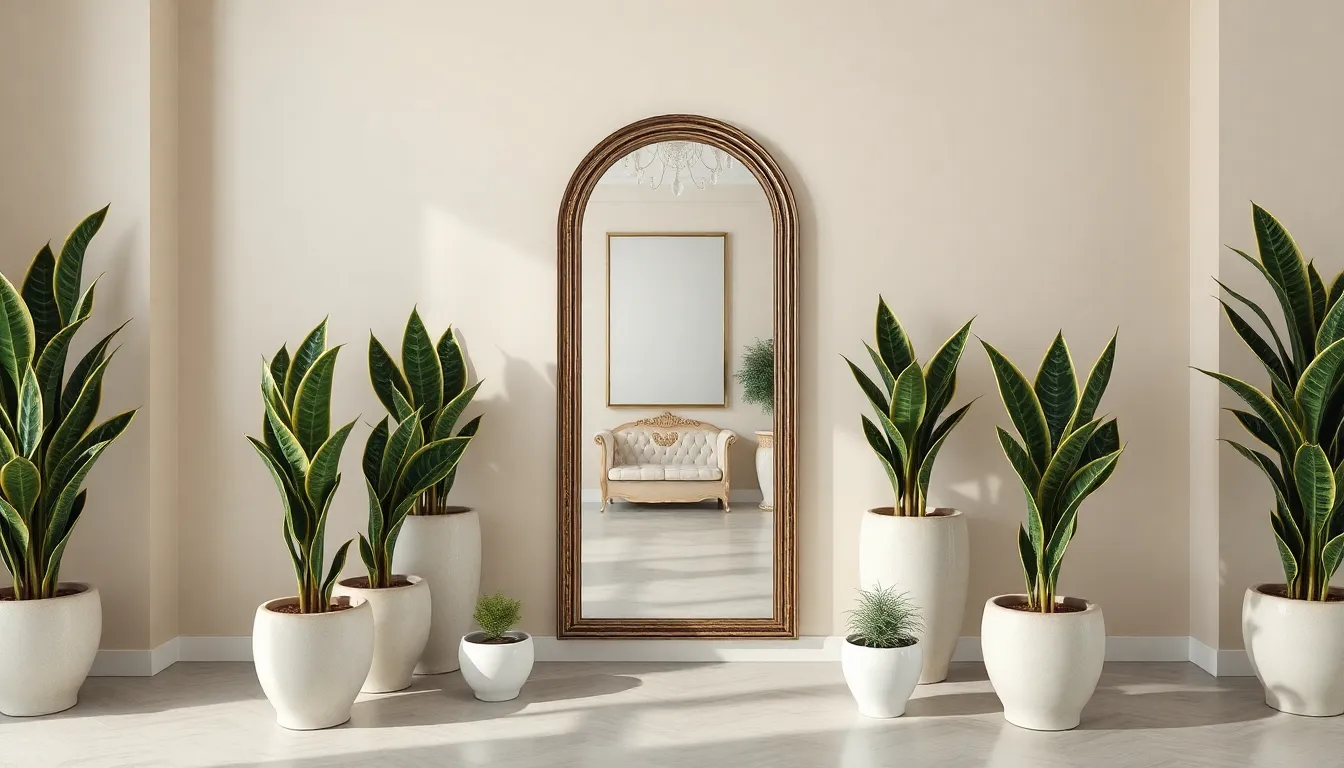
Symmetry creates the foundation for achieving visual harmony when we position plants around mirrors. This balanced approach transforms our mirror displays into sophisticated focal points that feel intentional and professionally designed.
Create Matching Plant Pairs on Either Side
Matching plant pairs establish the core principle of symmetrical design around our mirrors. We select identical species with similar sizes and shapes to place on both sides of the mirror frame. Snake plants work exceptionally well for this purpose because their upright growth pattern and uniform leaves create clean, geometric lines.
Pairing identical plants creates a mirror effect within the arrangement itself, reinforcing the reflective theme of our central mirror. We achieve the most striking results when we choose plants that naturally display radial or mirror symmetry, such as aloe polyphylla or certain succulent varieties. These geometrically symmetrical plants align perfectly with our overall design intention.
Size consistency matters significantly in our plant pairings. We measure our chosen plants to ensure they match in height, width, and overall proportions before positioning them. This attention to detail prevents visual imbalance that could disrupt the symmetrical flow we’re creating.
Use Identical Planters for Cohesive Look
Identical planters serve as the unifying element that ties our symmetrical arrangement together. We select matching containers in terms of material, color, size, and shape to maintain visual cohesion throughout our design. Ceramic pots in neutral tones work particularly well because they don’t compete with our plants or mirror for attention.
Planter consistency prevents distractions from our carefully planned symmetrical layout. We avoid mixing different planter styles within the same arrangement, as this breaks the visual flow and creates unwanted focal points. Instead, we invest in quality matching containers that complement both our plants and the mirror’s frame material.
Simple planter designs often prove most effective for symmetrical arrangements. We choose clean lines and minimal ornamentation that won’t interfere with the natural beauty of our plants or the reflective properties of our mirror. This restraint allows the symmetry itself to become the standout design feature.
Incorporate Hanging Plants to Frame Your Mirror Beautifully
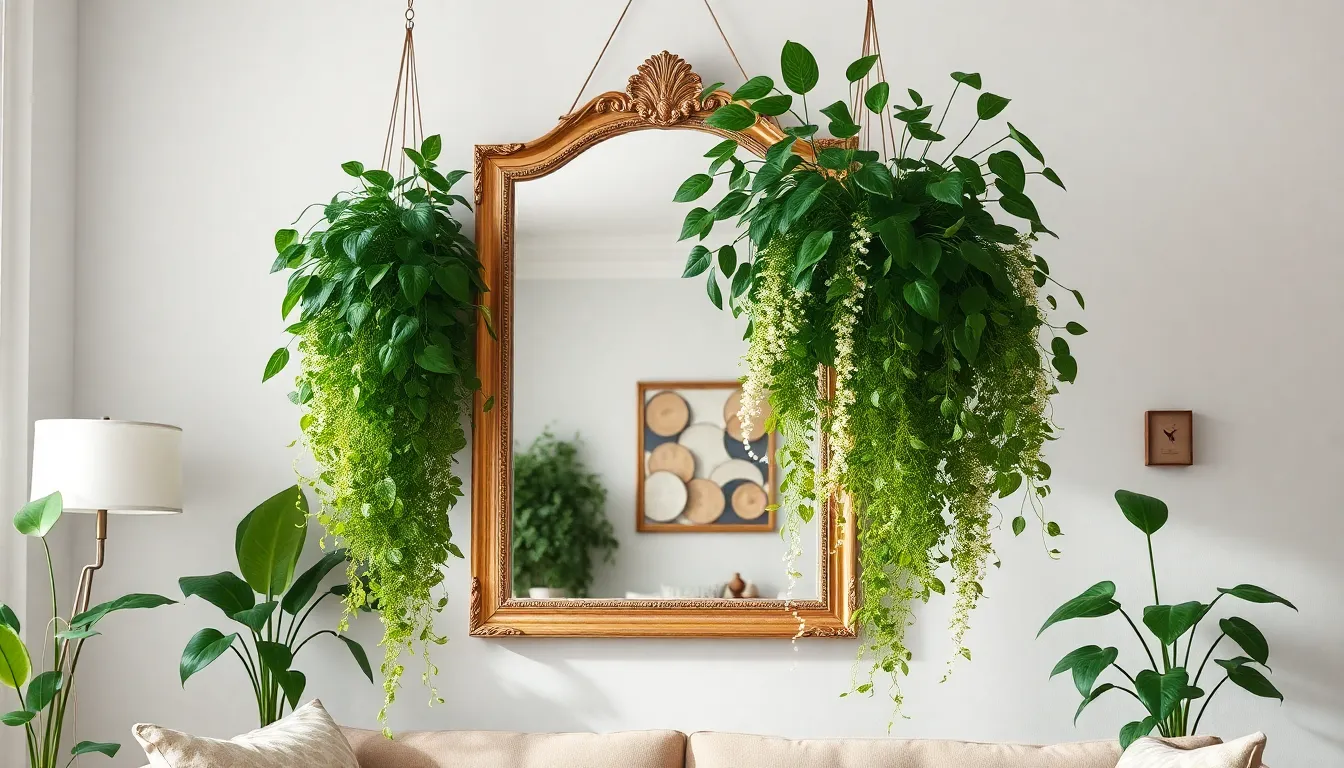
Creating a natural border around your mirror with hanging plants transforms the reflective surface into a living art piece. We’ll show you how to achieve this stunning effect using suspended planters and the right plant selections.
Install Ceiling Hooks for Suspended Planters
Mounting ceiling hooks directly above or around your mirror creates the perfect foundation for suspended plant displays. We recommend positioning these hooks at varying heights to establish visual depth and prevent a flat appearance. Heavy-duty ceiling hooks can support multiple planters, allowing cascading foliage to frame your mirror naturally without requiring any floor or wall space.
Strategic hook placement lets you suspend planters in front of the mirror’s edges while maintaining clear sightlines to the reflective surface. We’ve found that installing hooks 12 to 18 inches away from the mirror’s perimeter provides optimal spacing for plant growth. This distance prevents overcrowding while ensuring the trailing plants create that desired organic frame effect.
Suspended planters maximize your vertical growing space and add three-dimensional movement to your mirror area. We suggest using adjustable hanging systems that let you modify planter heights as your plants grow and change throughout the seasons.
Choose Cascading Varieties for Dramatic Effect
Selecting plants with natural trailing growth patterns creates the most impressive visual impact around mirrors. We recommend pothos, string of pearls, and ivy as top choices because their cascading nature draws the eye along the mirror’s edges while amplifying the sense of space indoors.
These trailing varieties thrive in the indirect light that mirrors naturally provide, making them perfect companions for reflective surfaces. We’ve observed that string of pearls creates particularly stunning effects with its unique bead-like foliage that catches and reflects light beautifully. Pothos offers lush, heart-shaped leaves that create dense, flowing curtains of greenery.
Ivy varieties provide classic elegance with their traditional trailing appearance and can adapt to various light conditions commonly found near mirrors. We prefer these cascading plants because they require minimal maintenance while delivering maximum visual drama. Their downward growth naturally complements vertical mirror installations and creates that sought-after biophilic design element that brings nature directly into your living space.
Select Complementary Planters That Enhance Your Mirror’s Frame
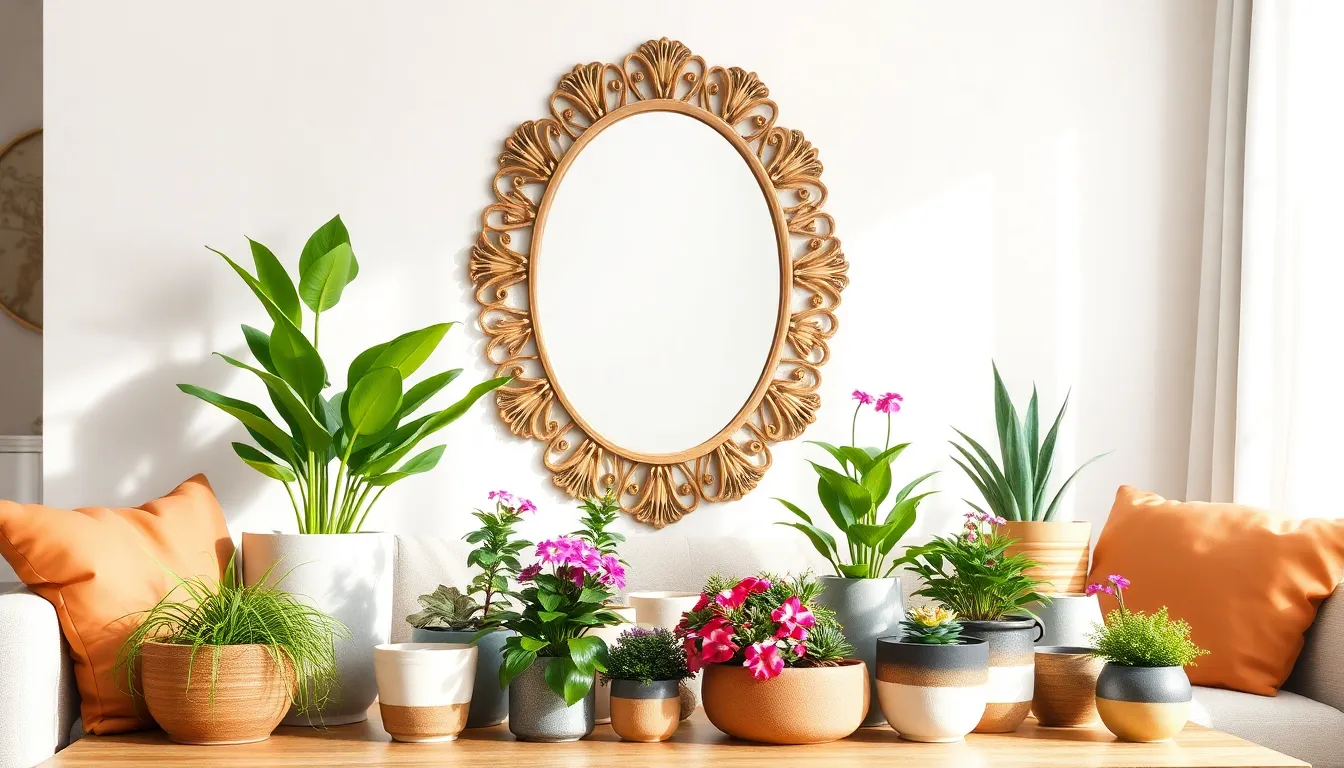
We’ve established how to position plants around mirrors, but choosing the right planters creates the visual harmony that makes your mirror and plant combination truly shine. Strategic planter selection transforms your arrangement from simple decoration into a cohesive design statement.
Match Planter Materials to Mirror Frame
Wooden mirror frames harmonize perfectly with clay or terracotta pots, creating warmth and an earthy atmosphere that feels grounded and natural. Metal framed mirrors look striking when paired with planters featuring metallic finishes or minimalist concrete containers, bringing a contemporary edge to your space.
Glass mirrors work beautifully with ceramic planters that have clean lines, maintaining the sleek aesthetic while adding subtle texture. Ornate vintage frames pair wonderfully with decorative planters that echo similar detailing, creating layers of visual interest without overwhelming the mirror’s reflective surface.
Natural materials like bamboo or rattan planters complement rustic wooden frames by reinforcing organic textures throughout your arrangement. Modern acrylic or resin planters enhance contemporary mirror designs while maintaining the clean, uncluttered look that makes both elements stand out.
Consider Color Coordination Between Plants and Containers
Neutral colored pots in white, beige, or gray work exceptionally well with green plants, allowing the foliage to become the star while maintaining balance with your mirror’s frame. Earth tones like terracotta, brown, or sage green create a cohesive palette that feels natural and calming around reflective surfaces.
Vibrant or flowering plants benefit from soft pastel colored containers that add visual interest without competing with the mirror’s focal point. Complementary colors like soft blues with orange blooms or pale yellows with purple flowers create sophisticated combinations that enhance both plant and mirror appeal.
Monochromatic schemes using varying shades of the same color family create depth while maintaining visual unity throughout your arrangement. Black or dark charcoal planters provide dramatic contrast that makes both colorful plants and metallic mirror frames pop with increased visual impact.
We recommend avoiding overly bright or neon colored containers that can clash with the mirror’s reflective properties and distract from the overall design harmony you’re trying to achieve.
Maintain Proper Plant Care in Mirror-Adjacent Locations
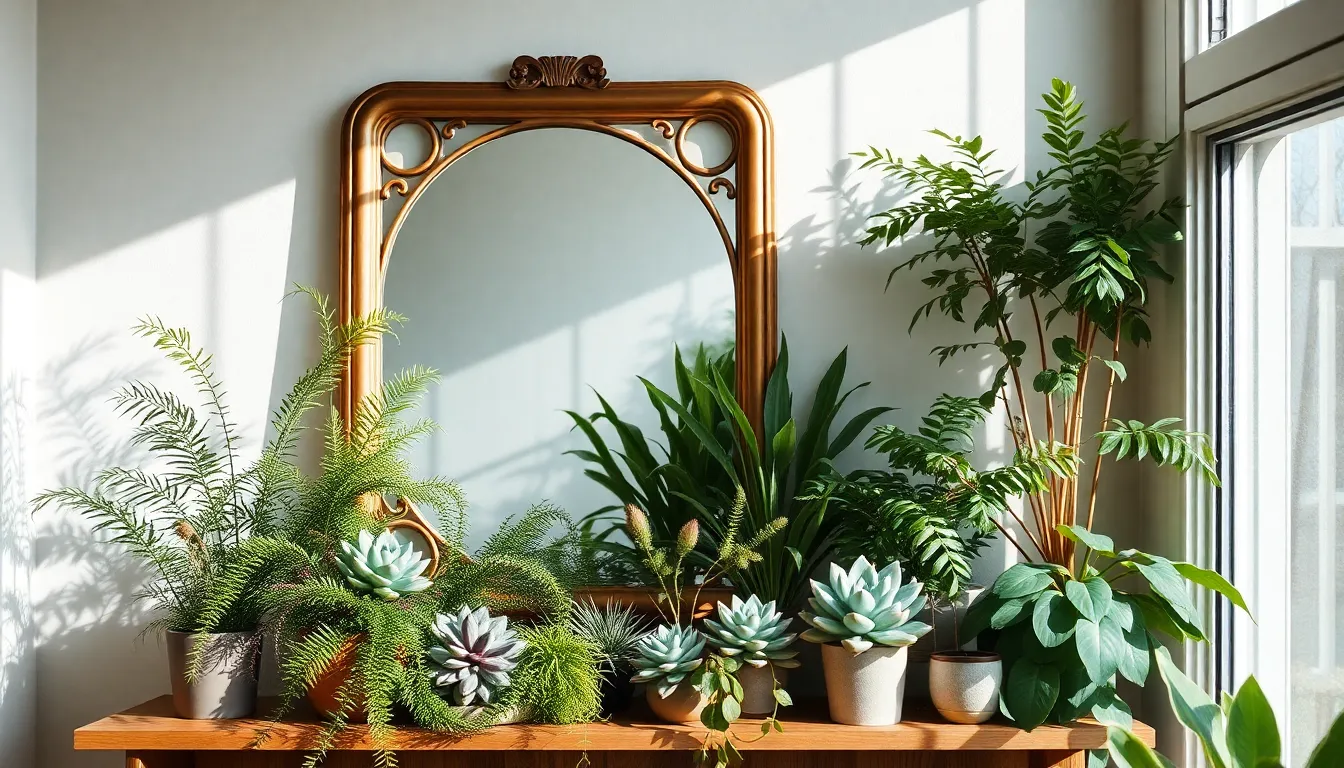
Mirrors dramatically alter the microenvironment around our plants by reflecting light and potentially changing temperature and humidity levels. We must adapt our care routines to ensure our plants thrive in these enhanced light conditions.
Monitor Humidity Levels Near Reflective Surfaces
Reflective surfaces can reduce humidity around plants by increasing local light intensity and heat. We need to track humidity levels regularly since mirrors bounce additional light onto our plants, potentially drying out the surrounding air faster than normal conditions.
Moisture loving plants require extra attention when placed near mirrors since they’re particularly sensitive to humidity changes. Digital hygrometers help us monitor these levels accurately, allowing us to make adjustments before our plants show stress signs.
Grouping plants together near mirrors creates beneficial microclimates through transpiration from multiple plants. We can also place water filled trays near our mirror plant arrangements to naturally increase humidity levels in the immediate area.
Adjust Watering Schedule for Increased Light Exposure
Research shows that mirrors can increase plant growth by up to 175% by reflecting additional sunlight onto shaded plants. This enhanced light exposure accelerates soil drying and increases transpiration rates, requiring us to modify our watering schedules accordingly.
Soil moisture sensors provide precise data about water content levels, helping us avoid both overwatering and dehydration in our mirror adjacent plants. We should check soil moisture more frequently since the reflected light can cause faster water evaporation from both soil and plant leaves.
Seedlings grown with below plant mirrors showed 51% increased height growth, indicating how dramatically mirrors affect plant metabolism and water needs. We must observe our plants closely during the first few weeks after introducing mirrors to establish new watering patterns that support this enhanced growth.
Plants positioned directly in mirror reflection zones may need watering every few days instead of weekly, depending on the species and light intensity. Establishing consistent monitoring routines ensures our plants receive adequate moisture without becoming waterlogged from overcompensating for the increased light exposure.
Style Different Room Types With Mirror and Plant Combinations

Each room in your home presents unique opportunities for combining mirrors with plants. We’ll explore how to tailor these combinations to enhance exact spaces and their functions.
Bathroom Mirrors With Humidity-Loving Plants
Bathrooms naturally create the perfect environment for moisture-loving plants when paired with mirrors. We recommend placing ferns, spider plants, or philodendrons near bathroom mirrors to take advantage of the humid conditions these spaces provide.
Mirrors amplify both light and the visual impact of humidity-loving plants, creating a spa-like atmosphere that transforms your daily routine. Hanging planters with trailing varieties work exceptionally well above or beside bathroom mirrors, while wall-mounted options keep surfaces clear for functionality.
Consider these moisture-tolerant combinations:
- Ferns positioned on floating shelves beside round mirrors
- Spider plants in hanging planters that cascade around vanity mirrors
- Philodendrons trailing from wall-mounted containers near medicine cabinet mirrors
Fake plants offer a low-maintenance alternative for bathrooms with limited natural light, ensuring you can achieve the aesthetic without compromising plant health.
Living Room Focal Points With Statement Plants
Living rooms benefit from bold mirror and plant combinations that command attention. We suggest pairing large mirrors with statement plants like fiddle leaf figs, monstera, or rubber plants to create ever-changing focal points on main walls.
Statement plants positioned near mirrors double their visual impact through reflection, adding both depth and brightness to living spaces. Floor-standing mirrors beside tall plants anchor seating areas elegantly, while pendant mirrors combined with hanging plants deliver a chic, modern aesthetic.
Effective living room combinations include:
- Fiddle leaf figs flanking oversized wall mirrors for dramatic effect
- Monstera plants positioned at angles where their distinctive leaves reflect prominently
- Rubber plants placed strategically to create layered reflections in multiple mirrors
Large mirrors serve as backdrops that amplify the lush greenery, making smaller living rooms appear more spacious and vibrant.
Bedroom Mirrors With Calming Plant Varieties
Bedrooms require gentle mirror and plant combinations that promote relaxation and restful sleep. We recommend pairing mirrors with low-maintenance, calming plants like snake plants, peace lilies, or ZZ plants that won’t overwhelm the peaceful ambiance.
Calming plant varieties enhance bedroom mirrors by adding soothing green presence while the mirror amplifies natural light for better plant health. Positioning mirrors with plants on dressers or near windows refreshes the room’s energy without creating visual chaos.
Ideal bedroom mirror and plant pairings:
- Snake plants beside full-length mirrors for clean, architectural lines
- Peace lilies on nightstands with vanity mirrors for gentle elegance
- ZZ plants positioned where dresser mirrors can reflect their glossy foliage
These combinations reduce stress and support tranquil environments while requiring minimal maintenance, perfect for spaces dedicated to rest and rejuvenation.
Conclusion
We’ve shown you how mirrors paired with plants can completely transform your living spaces into vibrant focal points that maximize light and create visual depth. This design approach works beautifully across every room in your home when you choose the right plant varieties and positioning strategies.
Remember that success lies in matching your plants to both the mirror’s style and the room’s lighting conditions. Whether you’re creating symmetrical arrangements or adding cascading elements we’ve covered the essential techniques to help you achieve professional-looking results.
The key is starting small and experimenting with different combinations until you find what works best for your space. With proper plant care and thoughtful planter selection you’ll create stunning mirror-plant displays that enhance your home’s natural beauty while making every room feel larger and more inviting.
Frequently Asked Questions
What are the main benefits of combining mirrors with plants in interior design?
Combining mirrors with plants enhances natural light reflection, increases the visual impact of greenery, and creates the illusion of a larger space. This design approach transforms mirrors into stunning focal points while amplifying both natural light and the beauty of plants, creating a harmonious and inviting atmosphere throughout your home.
How do I choose the right plants to complement different mirror styles?
Match plants to your mirror’s aesthetic: pair modern minimalist mirrors with architectural plants like snake plants, ornate vintage mirrors with cascading varieties like pothos, geometric mirrors with structured plants, and round mirrors with varied heights and textures. Consider the mirror’s frame and overall style when selecting complementary greenery.
What plants work best in different lighting conditions around mirrors?
For high light areas, choose sun-loving plants like succulents and cacti. Medium light conditions suit fiddle leaf figs and rubber trees. Low light areas work well with snake plants, ZZ plants, and pothos. Consider using artificial grow lights to expand your plant options in darker spaces.
How should I layer plants around mirrors for maximum visual impact?
Create depth by layering plant heights: place tall plants like bamboo and palms behind mirrors as backdrop, position medium-sized plants like fiddle leaf figs at mirror level for transition, and include trailing plants like ivy below or around the mirror to add movement and softness.
Which plants are best for reflecting light around mirrors?
Choose glossy-leaved plants that enhance light reflection, such as pothos, snake plants, peace lilies, rubber trees, fiddle leaf figs, monstera deliciosa, ZZ plants, and philodendrons. These plants not only thrive in bright, indirect light but also maximize the light-enhancing properties of nearby mirrors.
How can I create symmetrical plant arrangements around mirrors?
Design balanced arrangements using matching plant pairs on either side of the mirror for visual harmony. Choose plants of similar size and shape, and use complementary planters to maintain symmetry. This approach creates a polished, professional look that enhances the mirror’s impact.
What’s the best way to use hanging plants with mirrors?
Frame mirrors beautifully with cascading hanging plants like trailing pothos, ivy, or string of pearls. Install hanging planters at appropriate heights to create dramatic effects without blocking the mirror’s reflection. Ensure proper installation to support the weight of plants and planters safely.
How do I select planters that complement my mirror’s frame?
Choose planters that coordinate with your mirror’s frame material and color. Match metals, complement wood tones, or select neutral colors that don’t compete with the mirror’s design. Consider the planter’s shape and size to maintain visual unity and enhance the overall aesthetic.
Do plants need different care when placed near mirrors?
Yes, mirrors can alter the microenvironment by increasing light and potentially affecting humidity levels. Monitor your plants more closely for changes in watering needs and watch for signs of too much reflected light. Adjust positioning if plants show stress from excessive light exposure.
What plant and mirror combinations work best in specific rooms?
For bathrooms, use humidity-loving plants like ferns and spider plants near mirrors for a spa-like feel. In living rooms, create focal points with bold combinations using statement plants like fiddle leaf figs and monstera. For bedrooms, choose calming plants such as snake plants and peace lilies to promote relaxation.

